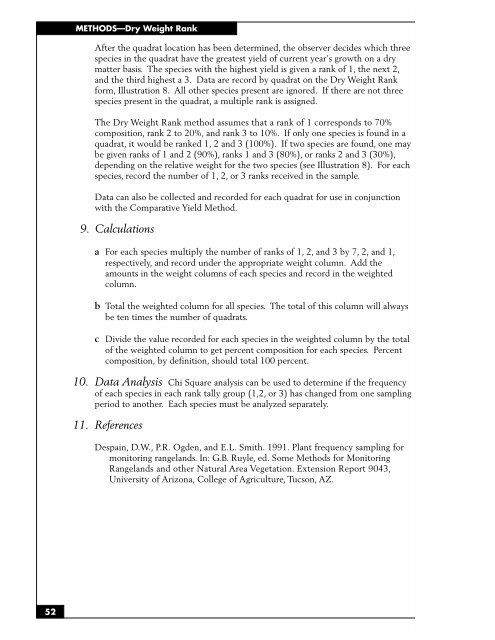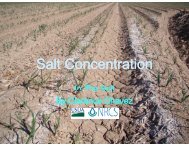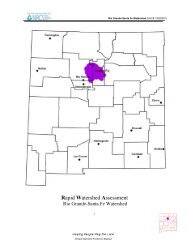SAMPLING VEGETATION ATTRIBUTES - New Mexico NRCS - US ...
SAMPLING VEGETATION ATTRIBUTES - New Mexico NRCS - US ...
SAMPLING VEGETATION ATTRIBUTES - New Mexico NRCS - US ...
You also want an ePaper? Increase the reach of your titles
YUMPU automatically turns print PDFs into web optimized ePapers that Google loves.
52<br />
METHODS—Dry Weight Rank<br />
After the quadrat location has been determined, the observer decides which three<br />
species in the quadrat have the greatest yield of current year’s growth on a dry<br />
matter basis. The species with the highest yield is given a rank of 1, the next 2,<br />
and the third highest a 3. Data are record by quadrat on the Dry Weight Rank<br />
form, Illustration 8. All other species present are ignored. If there are not three<br />
species present in the quadrat, a multiple rank is assigned.<br />
The Dry Weight Rank method assumes that a rank of 1 corresponds to 70%<br />
composition, rank 2 to 20%, and rank 3 to 10%. If only one species is found in a<br />
quadrat, it would be ranked 1, 2 and 3 (100%). If two species are found, one may<br />
be given ranks of 1 and 2 (90%), ranks 1 and 3 (80%), or ranks 2 and 3 (30%),<br />
depending on the relative weight for the two species (see Illustration 8). For each<br />
species, record the number of 1, 2, or 3 ranks received in the sample.<br />
Data can also be collected and recorded for each quadrat for use in conjunction<br />
with the Comparative Yield Method.<br />
9. Calculations<br />
a For each species multiply the number of ranks of 1, 2, and 3 by 7, 2, and 1,<br />
respectively, and record under the appropriate weight column. Add the<br />
amounts in the weight columns of each species and record in the weighted<br />
column.<br />
b Total the weighted column for all species. The total of this column will always<br />
be ten times the number of quadrats.<br />
c Divide the value recorded for each species in the weighted column by the total<br />
of the weighted column to get percent composition for each species. Percent<br />
composition, by definition, should total 100 percent.<br />
10. Data Analysis Chi Square analysis can be used to determine if the frequency<br />
of each species in each rank tally group (1,2, or 3) has changed from one sampling<br />
period to another. Each species must be analyzed separately.<br />
11. References<br />
Despain, D.W., P.R. Ogden, and E.L. Smith. 1991. Plant frequency sampling for<br />
monitoring rangelands. In: G.B. Ruyle, ed. Some Methods for Monitoring<br />
Rangelands and other Natural Area Vegetation. Extension Report 9043,<br />
University of Arizona, College of Agriculture, Tucson, AZ.




